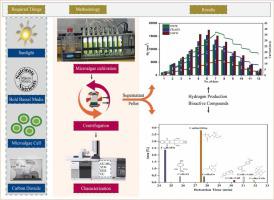当前位置:
X-MOL 学术
›
Process Saf. Environ. Prot.
›
论文详情
Our official English website, www.x-mol.net, welcomes your feedback! (Note: you will need to create a separate account there.)
A novel application of Chlorella sorokiniana for green hydrogen production via microbial electrolysis and Waste Biorefinery
Process Safety and Environmental Protection ( IF 6.9 ) Pub Date : 2024-06-20 , DOI: 10.1016/j.psep.2024.06.093 Ayesha Aslam , Ali Bahadar , Rabia Liaquat , Abdul Basit
Process Safety and Environmental Protection ( IF 6.9 ) Pub Date : 2024-06-20 , DOI: 10.1016/j.psep.2024.06.093 Ayesha Aslam , Ali Bahadar , Rabia Liaquat , Abdul Basit

|
Waste biorefineries have significant potential to utilize microbial electrolysis cells (MECs) to convert waste into energy carriers and bioproducts with added value, potentially resulting in a carbon- and energy-negative system. Various feedstocks (such as sodium acetate, glucose, glycerol, and wastewater) are used in MEC for biohydrogen production. This study used the three different wastewaters as substrates in the MEC for biohydrogen production. The remaining dried microalgal biomass was then analyzed to identify value-added compounds. Under conditions of 18±3°C, domestic wastewater (DWW) produced maximum biohydrogen (22.78±0.25 mL/L). Combined domestic wastewater and algal extracted supernatant (CDAES) resulted in a higher yield (30.82±0.25 mL/L), and modified wastewater (MWW) exhibited the highest production (40.86±0.25 mL/L). The biohydrogen production values in this study exceed those reported in the latest research, considering the applied voltage of 0.5 V. Scanning electron microscope (SEM) images confirmed the formation of rod-shaped and round-shaped microbial communities on the anode surface. The cultivation conditions for in a multi-cultivator system were set (23–26°C, 98 μmol m s, pH 7.0 ± 0.5, and CO 0.04 %). The Gas Chromatography-Mass Spectrometry (GC-MS) analysis of dried algal biomass has revealed eighteen bioactive compounds with diverse applications in pharmacy, food, and cosmetics. Thus, the algal extracted supernatant incorporated into wastewater demonstrated an innovative and economical feedstock for MEC. Additionally, bioactive compounds play a prominent role in the success of integration technologies, opening a new avenue for research.
中文翻译:

小球藻通过微生物电解和废物生物精炼生产绿色氢气的新应用
废物生物精炼厂具有利用微生物电解池(MEC)将废物转化为具有附加值的能源载体和生物产品的巨大潜力,可能会形成负碳和负能量的系统。 MEC 使用各种原料(如乙酸钠、葡萄糖、甘油和废水)来生产生物氢。本研究使用三种不同的废水作为 MEC 中的底物来生产生物氢。然后分析剩余的干燥微藻生物质以鉴定增值化合物。在18±3℃条件下,生活废水(DWW)产生最大生物氢(22.78±0.25mL/L)。生活废水和藻类提取上清液(CDAES)的结合产生了较高的产率(30.82±0.25mL/L),改性废水(MWW)的产率最高(40.86±0.25mL/L)。考虑到施加的电压为 0.5V,本研究中的生物氢产量值超过了最新研究报告的值,扫描电子显微镜 (SEM) 图像证实了阳极表面上棒状和圆形微生物群落的形成。设置多培养系统的培养条件(23-26°C,98 μmol m s,pH 7.0 ± 0.5,CO 0.04%)。对干燥藻类生物质的气相色谱-质谱 (GC-MS) 分析揭示了 18 种生物活性化合物,在制药、食品和化妆品中具有不同的应用。因此,将藻类提取的上清液掺入废水中,证明了 MEC 的一种创新且经济的原料。此外,生物活性化合物在集成技术的成功中发挥着重要作用,开辟了新的研究途径。
更新日期:2024-06-20
中文翻译:

小球藻通过微生物电解和废物生物精炼生产绿色氢气的新应用
废物生物精炼厂具有利用微生物电解池(MEC)将废物转化为具有附加值的能源载体和生物产品的巨大潜力,可能会形成负碳和负能量的系统。 MEC 使用各种原料(如乙酸钠、葡萄糖、甘油和废水)来生产生物氢。本研究使用三种不同的废水作为 MEC 中的底物来生产生物氢。然后分析剩余的干燥微藻生物质以鉴定增值化合物。在18±3℃条件下,生活废水(DWW)产生最大生物氢(22.78±0.25mL/L)。生活废水和藻类提取上清液(CDAES)的结合产生了较高的产率(30.82±0.25mL/L),改性废水(MWW)的产率最高(40.86±0.25mL/L)。考虑到施加的电压为 0.5V,本研究中的生物氢产量值超过了最新研究报告的值,扫描电子显微镜 (SEM) 图像证实了阳极表面上棒状和圆形微生物群落的形成。设置多培养系统的培养条件(23-26°C,98 μmol m s,pH 7.0 ± 0.5,CO 0.04%)。对干燥藻类生物质的气相色谱-质谱 (GC-MS) 分析揭示了 18 种生物活性化合物,在制药、食品和化妆品中具有不同的应用。因此,将藻类提取的上清液掺入废水中,证明了 MEC 的一种创新且经济的原料。此外,生物活性化合物在集成技术的成功中发挥着重要作用,开辟了新的研究途径。
















































 京公网安备 11010802027423号
京公网安备 11010802027423号